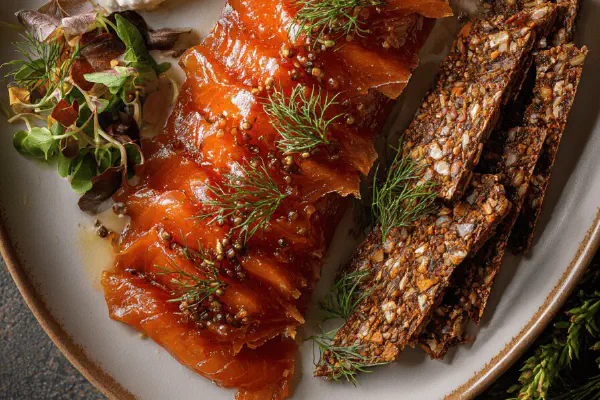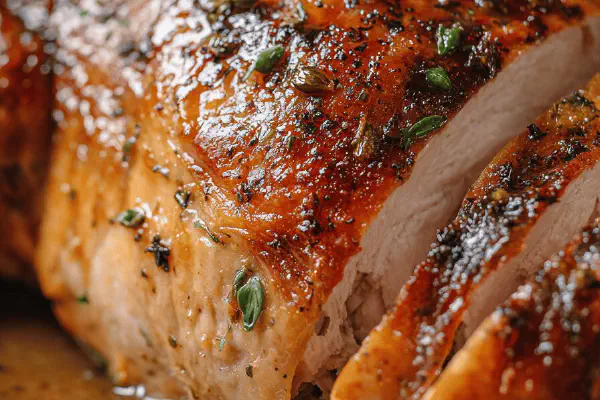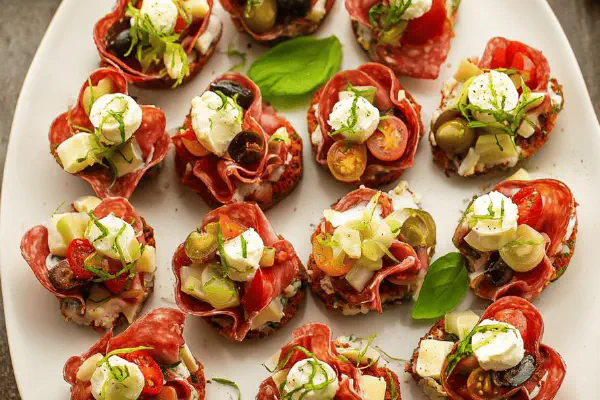Calvados Cured Salmon

By Emma
Certified Culinary Professional
Ingredients
- 20 ml salt (1 1/3 c. tsp)
- 25 ml organic cane sugar (1 2/3 c. tsp)
- 10 ml juniper berries, lightly crushed
- 3 ml white peppercorns, cracked
- 1 kg salmon fillet, skin removed
- 50 ml Calvados apple brandy
- to serve labneh or whipped ricotta
- to serve toasted rye bread slices
About the ingredients
Method
- Start with dry mix: salt, sugar, crushed juniper, white pepper. Grind the berries just enough to release oils but keep texture; over-crushing turns bitter.
- Rub this mix firmly into both sides of the salmon. Press hard to embed flavors. Looks wet with the sugar-salt sheen. Place fish in a glass dish, skin side down.
- Pour Calvados over all. Not too much or the flesh will mush. Apple brandy adds subtle fruitiness without overpowering.
- Cover tightly with plastic wrap. Refrigerate 18-24 hours. Not less or flesh won’t set; not more or it turns too dry. I found 20 hours hits balance: flesh firms, aroma brightens, not dry or too salty.
- Flip salmon halfway through curing - about 10 hours. Don’t skip this. Keeps moisture running evenly, avoids uneven cure spots. Fish changes texture visibly; edges firmer, center translucent pink.
- After curing, wipe off excess liquid with paper towels — crucial step to avoid watery slices. Dryness also helps to slice thinly without tearing.
- Slice into thin strips at an angle, against the grain. Use the sharpest fish knife you have. Thin slices show the beautiful gradient color: pale pink edges, deeper flesh inside.
- Serve cold with dollops of labneh or whipped ricotta — tangy, creamy contrasts the salt and brandy notes. Toasted rye rounds add crunch and earthy aroma.
- Labneh is a better choice than crème fraîche or cream cheese here; less fat masks the Calvados’ fruit tones, which I discovered after multiple tastings.
- If Calvados unavailable, try dry apple cider or a splash of white rum. Avoid over-sweet spirits; they mask the delicate curing flavors.
- Troubleshooting tip: if fish gets too salty, a quick rinse then pat dry before slicing helps. But best to monitor curing time carefully.
Cooking tips
Chef's notes
- 💡 Use glass or ceramic for curing; metal messes with flavor chemically. Crush juniper berries lightly so oils release but it’s not bitter powder. Mix salt and sugar dry first. Press firmly both sides of salmon, make sure it’s fully coated. Keep fish chilled constant under 4°C; don’t freeze before curing. Plastic wrap directly touches salmon flesh to avoid drying and oxidation.
- 💡 Flip fish carefully about halfway. About 10 hours in a 20-hour cure. Do NOT skip flip or you get uneven curing. Watch visual cues: edges firm up, center translucent pink. Texture changes tell you when cure’s working—not just time. Too short, mushy; too long, rubbery. Balance is key—experience helps sense it quick.
- 💡 After curing, blot excess moisture with paper towel — very important. Too wet slices tear, mush when cutting thin. Use sharpest knife possible, slice thin against grain angle. Keep fingers steady to avoid tearing. Thin slices reveal gradient of pale edges to deeper pink center; visual sign you got it right.
- 💡 Labneh or ricotta instead of cream cheese or crème fraîche keeps flavors sharper. Fat in heavy creams dulls fruity apple notes in Calvados. Toast rye bread just until crackling but still tender inside. Cast iron pan toast adds aroma better than toaster. If no Calvados, try dry apple cider or white rum splash, but be cautious with strong spirits masking flavor.
- 💡 If fish ends salty, rinse quickly with cold water, pat dry well before slicing. Longer curing needs trimming time or reduce salt sugar by about 30%. Keep knife sharp, salmon fresh smelling never fishy. Let cured fish rest room temp 15 mins after fridge before slicing; flavors open. Adjust time slightly by fillet thickness and freshness.
Common questions
How long to cure salmon?
Around 18 to 24 hours usually. I do 20. Flip halfway. Watch texture edges firm, center translucent. Not firm, extend time. Too dry, shorten cure. Thickness matters.
Substitute for Calvados?
Dry apple cider works okay. Also add splash white rum for fruit note. Avoid sweet spirits like liqueurs. Vinegar mix can help but alters flavor profile. Keep balance tuned, don’t overpower fish.
Why blot salmon after curing?
Stops watery slices. Water dilutes flavor and texture falls apart slicing thin. Paper towels, press gently. If too wet, tearing happens. Dry surface helps knife glide cleanly through flesh without mush.
How to store cured salmon leftovers?
Wrap tightly in plastic wrap or airtight container. Keep fridge temp below 4°C, good up to 3 days. Freeze not recommended due to texture loss. Small batches better for freshness. Let rest room temp before serving after fridge.



